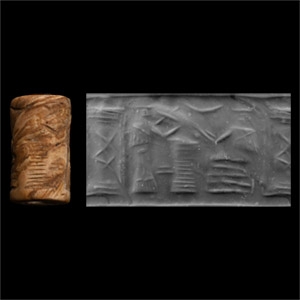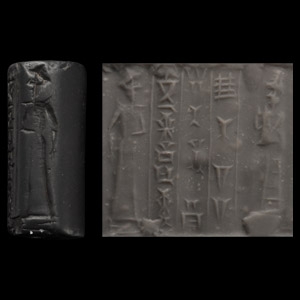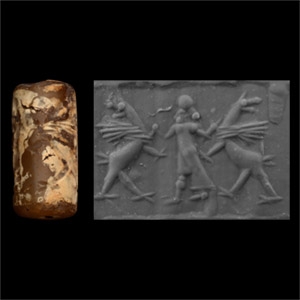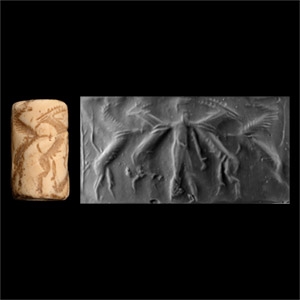Sold for (Inc. bp): £1,105
With two sections, upper section with two seated figures and two attendants, lower section with standing figure among animals; supplied with a museum-quality impression. 12.4 grams, 33 mm
From the collection of the late S, London, UK, 1970-2000.
Examined by Professor Wilfrid George Lambert FBA (1926-2011), historian, archaeologist, and specialist in Assyriology and Near Eastern archaeology, in the 1990s.
This lot has been cleared against the Art Loss Register database, and is accompanied by an illustrated lot declaration signed by the Head of the Antiquities Department, Dr Raffaele D'Amato.
Sold for (Inc. bp): £3,120
Columnar in form with frieze depicting a standing Lamma goddess in flounced robe facing towards a god wearing a pleated garment and holding a mace at his hip; disc-and-crescent motif above; behind, the storm-god Adad with one foot on a mound, wielding a lightning bolt in his raised hand. 11 grams, 25 mm
Private collection, Europe.
with Bonhams, London, 22 April 1999, no.538.
Acquired by the present owner from the above.
Accompanied by copies of the relevant Bonhams catalogue pages.
This lot has been checked against the Interpol Database of stolen works of art and is accompanied by a search certificate number no.12538-232100.
This lot has been cleared against the Art Loss Register database, and is accompanied by an illustrated lot declaration signed by the Head of the Antiquities Department, Dr Raffaele D'Amato.
With frieze depicting two standing robed figures facing a seated figure in flounced robe, objects in the field; two columns of cuneiform text, reading 'Hadada, son of Lugal...na'; supplied with a museum-quality impression. 12.6 grams, 28 mm
From the collection of the late S, London, UK, 1970-2000.
Examined by Professor Wilfrid George Lambert FBA (1926-2011), historian, archaeologist, and specialist in Assyriology and Near Eastern archaeology, in the 1990s.
This lot has been cleared against the Art Loss Register database, and is accompanied by an illustrated lot declaration signed by the Head of the Antiquities Department, Dr Raffaele D'Amato.
With cord and bead handles; accompanied by a copy of an old scholarly note, typed and signed by W.G. Lambert, late Professor of Assyriology, University of Birmingham, 1970-1993, which states: 'Description of Cylinder Seal of Fossil Shell 30 x 16.5 mm. A god standing in the centre succours a domestic animal on either side which is being attack[ed] in turn by a lion. Terminal: two line[s] below vacant description panel. The seal is of late ED III or early Akkad date, c. 2400-2200 B.C. The cutting is marked by a strong use of the drill. The seal is worn, though the design clear. The meaning of the design is based on real life. Lions were a real threat to the herds and flocks of the community, and it was hoped that the depiction of a god coming to the rescue of the domestic creatures would mean that in real life their animals would be similarly saved by divine help.'; accompanied by a museum-quality impression. 16.1 grams total, 8.1-29.57 mm
UK private collection, acquired 1980-1983.
Accompanied by a copy of a scholarly note, typed and signed by Professor Wilfrid George Lambert in August 1990.
This lot has been cleared against the Art Loss Register database, and is accompanied by an illustrated lot declaration signed by the Head of the Antiquities Department, Dr Raffaele D'Amato.
Depicting seated god facing three standing figures, restrung pair of red stone beads, old handwritten label '1648'; accompanied by a copy of an old scholarly note, typed and signed by W.G. Lambert, late Professor of Assyriology, University of Birmingham, 1970-1993, which states: 'Cylinder Seal of Cream Fossil Shell, 35 x 22 mm. On the right sits a god, bearded, hair done up in a bun, wearing a horned tiara and a long, flounced robe, and raising one hand' before him stands a deity in a long robe falling in pleats and holding by the wrist a worshipper behind, who is bringing a kid as a gift to the seated god. The worshipper's wife stands behind him, with different hair style but similar clothing, holding a bucket in one hand. There is a crescent moon in the sky and between the two gods an oblong filled with circles; and a fish. This is an Akkadian seal from Mesopotamia or West Iran, c. 2300-2200 B.C. The presentation scene it shows was meant to be understood as the seal owner and his wife being introduced to an important god who could help them. The oblong object with circles in not certainly understood, but it may be a tray in which small cheese were put to drain.'; accompanied by a museum-quality impression. 30.9 grams, 35 mm
Armand Trampitsch, Glyptique Archéologie, Paris, Hôtel Drouot, 13-14 May 1992, no.23 [Part].
Accompanied by a copy of a scholarly note, typed and signed by Professor Wilfrid George Lambert in 1992.
This lot has been cleared against the Art Loss Register database, and is accompanied by an illustrated lot declaration signed by the Head of the Antiquities Department, Dr Raffaele D'Amato.
With figures and fire altar, restrung pair of red stone beads, old handwritten label '1649'; accompanied by a copy of an old scholarly note, typed and signed by W.G. Lambert, late Professor of Assyriology, University of Birmingham, 1970-1993, which states: 'Cylinder Seal of Fawn Fossil Shell, 35 x 20.5 mm. On the right sits a snake god: human body above the waist, curling snake below, with one hand extended. Facing him stands a god in long robe with bottom fringe, also extending one hand. Between them is a fire altar. Behind each god is a sideboard for holding food and drink ready to consume. There is a lunar crescent in the sky. This is an Akkadian seal from Mesopotamia or Western Iran, c. 2300-2200 B.C. The snake god is not yet identified from texts, but is a fascinating item of Akkadian mythology.'; accompanied by a museum-quality impression. 30 grams, 35 mm
Armand Trampitsch, Glyptique Archéologie, Paris, Hôtel Drouot, 13-14 May 1992, no.23 [Part].
Accompanied by a copy of a scholarly note, typed and signed by Professor Wilfrid George Lambert in 1992.
This lot has been cleared against the Art Loss Register database, and is accompanied by an illustrated lot declaration signed by the Head of the Antiquities Department, Dr Raffaele D'Amato.
With three columns of cuneiform inscription, reading 'Sherum-ili, son of Begum, servant of Ninsianna', a standing robed figure on each side; accompanied by a museum-quality impression. 9.53 grams, 25 mm
From the collection of the late S, London, UK, 1970-2000.
Examined by Professor Wilfrid George Lambert FBA (1926-2011), historian, archaeologist, and specialist in Assyriology and Near Eastern archaeology, in the 1990s.
This lot has been cleared against the Art Loss Register database, and is accompanied by an illustrated lot declaration signed by the Head of the Antiquities Department, Dr Raffaele D'Amato.
With standing divine figure and animals, restrung pair of red stone beads, old handwritten label '1605'; accompanied by a copy of an old scholarly note, typed and signed by W.G. Lambert, late Professor of Assyriology, University of Birmingham, 1970-1993, which states: 'Cylinder Seal of Yellow Chalcedony with Ivory Coating in Part. 33 x 16 mm. The engraving shows a standing god dressed in a long robe open at the front, from which one leg projects, holding off on either side a winged quadruped which is facing backwards. This is typical Late Assyrian or Late Babylonian seal dating c. 800-600 B.C., engraved with a combination of cutting wheel and drill. The purpose of the scene is to display the power of the god, no doubt meant as the god of the seal owner, but there is nothing to indicate exactly which god the seal engraver had in mind. Apart from a chip off the upper edge not reaching the design, the seal is in very good state of preservation.'; accompanied by a museum-quality impression. 16.7 grams, 33 mm
UK private collection, acquired 1980-1983.
Accompanied by a copy of a scholarly note, typed and signed by Professor Wilfrid George Lambert in 1991.
This lot has been cleared against the Art Loss Register database, and is accompanied by an illustrated lot declaration signed by the Head of the Antiquities Department, Dr Raffaele D'Amato.
With cord and bead handles; accompanied by a copy of an old scholarly note, typed and signed by W.G. Lambert, late Professor of Assyriology, University of Birmingham, 1970-1993, which states: 'Cylinder seal of fossil shell. 28 x 16 mm., condition good. Contest scene: standing hero succours reared up domestic animal on either side as they are attacked by lions, a second hero pulls the tail of the right-hand lion from behind; terminal scorpion below double line. This well known type of Sumerian seal occurs at the very end of the Early Dynastic periods, and on into the beginning of the Akkad dynasty. The scene involves divine heroes, and it was hoped that in actual life such figures would save domestic herds from attacks of lions.'; accompanied by a museum-quality impression. 14.9 grams total, 8.1-27.78 mm
UK private collection, acquired 1980-1983.
Accompanied by a copy of a scholarly note, typed and signed by Professor Wilfrid George Lambert in August 1990.
This lot has been cleared against the Art Loss Register database, and is accompanied by an illustrated lot declaration signed by the Head of the Antiquities Department, Dr Raffaele D'Amato.
Cylinder with standing male figure with a pair of animals to each side, restrung pair of red stone beads, old handwritten label '1647'; accompanied by a copy of an old scholarly note, typed and signed by W.G. Lambert, late Professor of Assyriology, University of Birmingham, 1970-1993, which states: 'Cylinder Seal of Cream Fossil Shell, 37 x 22 mm. In the centre stands a divine hero, nude, and gripping the neck of a horned animal on either side, each of which is being attacked by a lion with erect tail. For a terminal there stands a tall tree. This is an early Akkadian seal from Mesopotamia or West Iran, c. 2300 B.C. The symbolism comes from temple herds, which were liable to be attacked by lions at this time. They believed that certain gods and divine heroes could rescue their animals from such attacks, and by showing such scene on their seals they hoped to achieve the result be sympathetic magic.'; accompanied by a museum-quality impression. 37.6 grams, 37 mm
Armand Trampitsch, Glyptique Archéologie, Paris, Hôtel Drouot, 13-14 May 1992, no.23 [Part].
Accompanied by a copy of a scholarly note, typed and signed by Professor Wilfrid George Lambert in 1992.
This lot has been cleared against the Art Loss Register database, and is accompanied by an illustrated lot declaration signed by the Head of the Antiquities Department, Dr Raffaele D'Amato.
With animals and standing figure, restrung pair of red stone beads, old handwritten label '1614'; accompanied by a copy of an old scholarly note, typed and signed by W.G. Lambert, late Professor of Assyriology, University of Birmingham, 1970-1993, which states: 'Cylinder Seal of Hematite, 19.5.x9.5 mm. The design consists of one item occupying the full height of the space, the other items being in effect in two registers. The human figure is full-height, wearing a robe to the ground, holding one hand to the waist, the other up. The lower register consists mainly of two recumbent horned animals, each facing backwards towards a sacred- tree. To the right is a smaller quadruped, to the left a rosette and star. Above a griffin is attacking a quadruped, while behind. The griffin is another quadruped, but horned and recumbent. This seal is Mitanni Elaborate Style, c. 1500-1200 B.C. from Syria or north Mesopotamia. It is cut, as normal for this type of seal, mainly with the cutting wheel and drill, and is a fine example of its kind.'; accompanied by a museum-quality impression. 6.2 grams, 19 mm
UK private collection, acquired 1980-1983.
Accompanied by a copy of a scholarly note, typed and signed by Professor Wilfrid George Lambert in 1991.
This lot has been cleared against the Art Loss Register database, and is accompanied by an illustrated lot declaration signed by the Head of the Antiquities Department, Dr Raffaele D'Amato.
With three columns of cuneiform text: 'Ahi-shagish, son of Sinia, Servant of Amurru', standing figure of a god holding sceptre facing a worshipper accompanied by a goddess wearing long robe and horned crown; supplied with a museum-quality impression. 14.4 grams, 26 mm
From the collection of the late S, London, UK, 1970-2000.
Examined by Professor Wilfrid George Lambert FBA (1926-2011), historian, archaeologist, and specialist in Assyriology and Near Eastern archaeology, in the 1990s.
This lot has been cleared against the Art Loss Register database, and is accompanied by an illustrated lot declaration signed by the Head of the Antiquities Department, Dr Raffaele D'Amato.



.jpg)
.jpg)




.jpg)






